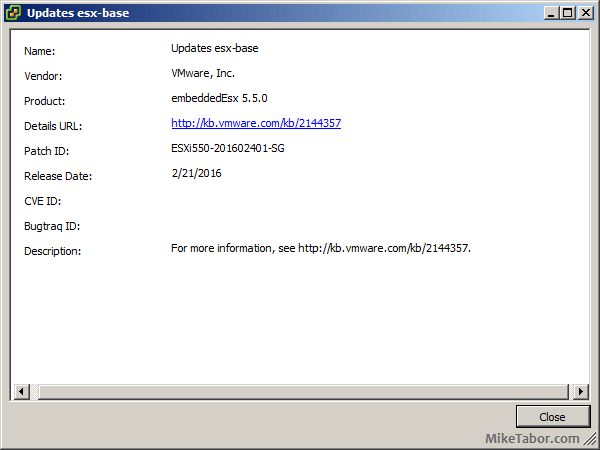Similar Posts
VMware Workstation 12 Pro Released
VMware has just released a new version of Workstation in VMware Workstation 12 Pro. Workstation 12 Pro provides full support for Windows 10, including features such as Cortana and universal applications. As well as even larger virtual machines with up to 16 vCPU’s and 64GB of memory. Workstation 12 Pro even supports 4K displays and DirectX 10 and OpenGL 3.3
You can even seamlessly drag and drop virtual machines between your PC and your internal cloud running vSphere, ESXi or another instance of Workstation. In addition, easily connect to vCloud Air and upload, run, and view virtual machines right from the Workstation 12 Pro interface.
VMware vCenter 5.0 Update 1a released
VMware vCenter 5.0 Update 1a has just been released and is the first major update since version 5.0.
The main improvements being:
- vCenter Server 5.0 Update 1a introduces support for the following vCenter Databases
- Oracle 11g Enterprise Edition, Standard Edition, Standard ONE Edition Release 2 [11.2.0.3] – 64 bit
- Oracle 11g Enterprise Edition, Standard Edition, Standard ONE Edition Release 2 [11.2.0.3] – 32 bit
- vCenter Server Appliance Database Support: The DB2 express embedded database provided with the vCenter Server Appliance has been replaced with VMware vPostgres database. This decreases the appliance footprint and reduces the time to deploy vCenter Server further.
- vCenter Server 5.0 Update 1a introduces support for the following vCenter Databases
VMware VCP5-DCV Delta Re-certification Exam

Looking to renew your VCP before the March 10th 2015 expiration date? Then the new VMware VCP5-DCV Delta (Exam Code VCP550D) is a cheaper way to renew your VCP without taking the full on exam or not just ready to tackle the VCAP. The new exam covers new material between the vSphere 5.0/5.1 and vSphere 5.5 exams – looking the the blueprints, most noticeably VSAN.
While you still have to schedule the exam through Pearson VUE, you don’t have to take the course at a testing center and instead can take it online from any device!
How to fix vRealize Orchestrator 6 appliance, weak ephemeral Diffie-Hellman key
I’ve recently deployed the vRealize Orchestrator appliance (6.0.2) and noticed right away that my default browser Firefox, would not load the Orchestrator appliance web panel. Firefox always complained about a weak Diffie-Hellman key.
“An error occurred during a connection to ip-address:8281. SSL received a weak ephemeral Diffie-Hellman key in Server Key Exchange handshake message. (Error code: ssl_error_weak_server_ephemeral_dh_key)”
At the time I simply ignored it and just tried Google Chrome which it worked fine. That was until the latest release also broke with the same type of error message:
“Server has a weak ephemeral Diffie-Hellman public key“.
I now had a problem and contacted VMware support, below is the very easy fix to make vCO 6 work in both the latest version of Firefox and Chrome!
Read More “How to fix vRealize Orchestrator 6 appliance, weak ephemeral Diffie-Hellman key”
HTML5 Embedded Host Client, this looks promising
It’s no secret many people have really disliked the vSphere web client, it’s very sluggish, clunky, and based on flash (flash comes with it’s own security issues). It was rumored and highly hoped that vSphere 6 might be re-written in HTML5, but sadly this didn’t and hasn’t happened yet. While vSphere 6 did improve a bit on the web client the issues many people have had with it in the past still remain today.
Enter the VMware HTML5 Embedded Host Client fling. I’ve been using and following this fling for a while now and have really enjoyed it and with each release it keeps getting better and better.
The Embedded Host Client fling is based on HTML5 which allows it works great across all kinds of platforms, it’s fast, responsive, and doesn’t require any plug-ins – YES the VM console works great. If this happens to be a look of what’s to come in a new VMware vSphere web client, then a client is looking very promising!
If you haven’t tried it yet, you should. It’s extremely easy to install and doesn’t even require a reboot just follow these simple instructions.
Read More “HTML5 Embedded Host Client, this looks promising”
VMware releases patch for glibc vulnerability on ESXi 5.5
You may remember not to long ago, the GHOST vulnerability found in glibc, a GNU C library. Well a new glibc vulnerability (CVE-2015-7547) has been discovered and it affects VMware ESXi 5.5 and 6.0 in addition to all versions of VMware virtual appliances running Linux such as vCenter, Orchestrator, vRealize, etc.
VMware has just released patch ESXi550-201602401-SG for ESXi 5.5 and ESXi600-201602401-SG for ESXi 6.0 which fixes the glibc vulnerability,
a patch for ESXi 6.0 has yet to be released. VMware has however posted workarounds for affected virtual appliances.Read More “VMware releases patch for glibc vulnerability on ESXi 5.5”


